MSI K8N Neo Platinum: First nForce3-250Gb
by Wesley Fink on April 26, 2004 12:05 AM EST- Posted in
- Motherboards
Basic Features: MSI K8N Neo Platinum
| Motherboard Specifications | |
| CPU Interface | Socket 754 Athlon 64 |
| Chipset | nVidia nForce3-250Gb |
| Bus Speeds | 200MHz to 300MHz (in 1MHz increments) |
| PCI/AGP Speeds | Auto, 66MHz to 100MHz (in 1MHz increments) |
| Core Voltage | Default to 1.81V in % increments (with 1.50V, 1.57V, 1.60V, 1.65V, 1.68V, 1.73V, 1.76V, 1.81V) |
| DRAM Voltage | Auto, 2.5V to 2.85V in 0.05V increments |
| AGP Voltage | 1.5V-1.85V in 0.05V increments |
| AUTO Overclock | D.O.T. Ranger, 1%, 3%, 5%, 7%, 9%, 11% |
| Memory Slots | Three 184-pin DDR DIMM Slots Unbuffered Non-ECC Memory to 2GB Total |
| Expansion Slots | 1 AGP 8X Slot 5 PCI Slots |
| Onboard SATA/IDE RAID | nVidia 4-Drive SATA Plus 4-Drive IDE IDE/SATA can be combined in 0, 1, 0+1 |
| Onboard IDE | Two Standard nVidia ATA133/100/66 (4 drives) |
| Onboard USB 2.0/IEEE-1394 | 8 USB 2.0 ports supported by nF3-250 2 1394A FireWire ports by VIA VT630 |
| Onboard LAN | Gigabit Ethernet on-chip by nF3-250GB |
| Onboard Audio | Realtek ALC850 8-Channel with UAJ |
| BIOS Revision | 1.13 (4/15/04) |
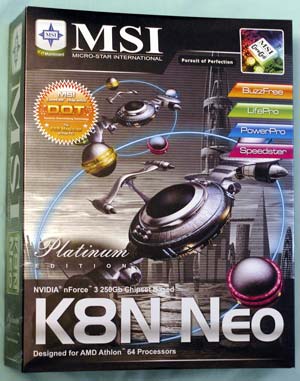
You should have no trouble finding the black-on-foil K8N Neo package on dealer's shelves. While the package is not as flashy as past MSI boards, the Platinum series still stands out.

Several manufacturers have been paying more attention lately to the internal protection and presentation of motherboards. MSI uses 2 internal packages; one for the accessories and manuals, and one for the motherboard itself.

MSI includes red-wrapped IDE and floppy cables, and orange SATA cables. Against the black K8N Neo, these will certainly stand out. A molex power converter is included for 2 SATA drives. Additional brackets are in the box for 2 additional USB Ports combined with MSI's trademark 4-LED diagnostics, and for standard and mini Firewire.
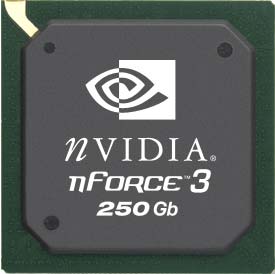
The single chip nVidia nForce3-250Gb is used for K8N Neo Platinum. For more information on this chipset, you can refer to our launch articles for this new chipset:
nForce3-250 - Part 2: Taking Athlon 64 to the Next Level
nForce3-250 - Part 1: Taking Athlon 64 to the Next Level
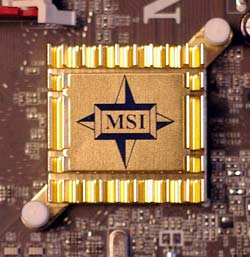
MSI used only a passive heatsink on the K8N Neo. We found that the heatsink got very hot after running for a few hours, particularly during overclocking. We would recommend that those planning to overclock or heavily load the K8N Neo replace the passive heatsink with an active heatsink and fan. Fortunately, standard mounting holes are provided and there are spare fan connectors nearby. The K8N Neo never crashed from the heat, but better cooling is likely needed.
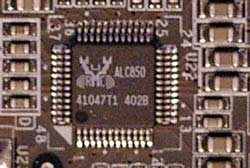
This is the first board that we have tested to use the Realtek ALC850 7.1 audio chip. This 8-channel audio codec is fully AC '97 2.3 compliant and features 16-bit 8-channel audio and auto-jack sensing with support for a full range of analog and digital IO. A wide range of sound standards are supported, including:
- EAXTM 1.0 & 2.0 compatible
- Direct Sound 3DTM compatible
- A3DTM compatible
- I3DL2 compatible
- HRTF 3D positional audio
- SensauraTM 3D Enhancement
You can find more details on the recently released ALC850 at Realtek product information.

The ALC650 is complemented by 5 audio mini-jacks plus both Optical and coaxial SPDIF connectors on the back IO panel. IO also includes PS2 mouse and keyboard, parallel, 1 serial, 1 standard Firewire (IEEE1394), 4 USB, and a Gigabit Ethernet port. MSI has provided an exceptional array of IO options on the M8N Neo Platinum, and buyers will generally be pleased with the provided options.
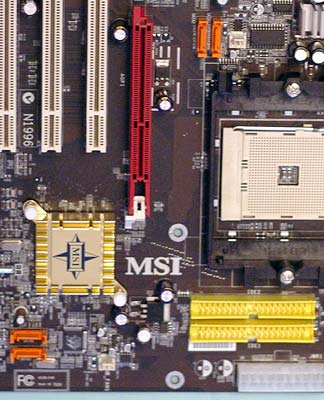
The K8N Neo fully supports the innovative nVidia "Any Drive" RAID. Any of the standard 4 IDE drives or an additional 4 SATA drives can be combined in a Raid 0 (striping), Raid 1 (Mirroring), or Raid 0+1 array. This is the most flexible RAID arrangement that we have seen built into any chipset.
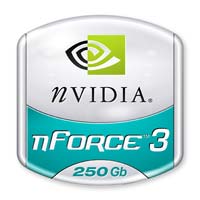
On-chip Gigabit LAN is built-in with the nF3-250Gb and runs completely independent of the PCI bus. This ensures that the LAN is always capable of providing the fastest throughput possible with your LAN connections.
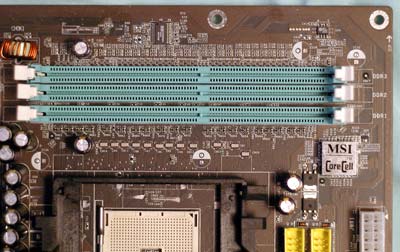
Three DIMM slots support up to 2GB of up to DDR400 memory in a Single-Channel memory configuration. The Athlon 64 will support Dual Channel memory with the introduction of Socket 939. However, as we have discussed in other reviews, the Athlon 64 is not as dependent on memory bandwidth as Pentium 4 solutions. The single-channel socket 754 is just as fast as the dual-channel Athlon 64 FX chips in many applications.










26 Comments
View All Comments
Wesley Fink - Monday, April 26, 2004 - link
#1 - This is the same CPU that has not been able to run 3 dimms in the past. Stepping is AP. I was also surprised 3 dimms worked at DDR400.#3 - MSI states that the K8N Neo Platinum fully supports Cool'n'Quiet. We did enable it and it does appear to be working. We ended up disabling Cool'n'Quiet for our overclocking tests to prevent any possible interference from this feature.
#4 - We will be changing standard test memory in the near future. Since so many tests have been done with the Mushkin/OCZ 3500, we continue using them so results can be compared to previous performance tests. We have also not yet determined which memory we will test with in the future.
NFS4 - Monday, April 26, 2004 - link
#3, my Asrock K8S8X fully supports Quiet-n-Cool on my A64 3200+ It idles at 800MHz, then switches from 1800MHz and then to 2000MHz depending on load. But I'd say that 90% of the time doing normal desktop work, it's at 800MHz. The only time I see it spike up is when I start a game or when I do something really CPU intensive.But remember, in order to get it to work, you have to have it enabled in BIOS and download the CPU driver from AMD's website and set your power management in Windows to "Minimal Power Management"
Fr0zeN2 - Monday, April 26, 2004 - link
Why do you keep testing with memory modules that aren't available on the market anymore?mikeymasta - Monday, April 26, 2004 - link
Theres been a lot of talk that no motherboard maker/chipset maker fully supports AMDs cool and quiet...Does any one know what the status of support is on this board chipset?
skiboysteve - Monday, April 26, 2004 - link
i dont like this video card specific tweaking at all...mechBgon - Monday, April 26, 2004 - link
Very interesting that this setup can run three double-sided DIMMs at DDR400 speeds. What stepping is the test system's CPU, if I may ask? Is it the same CPU that was not succeeding at running three DDR400 DIMMs stable on other boards/chipsets?